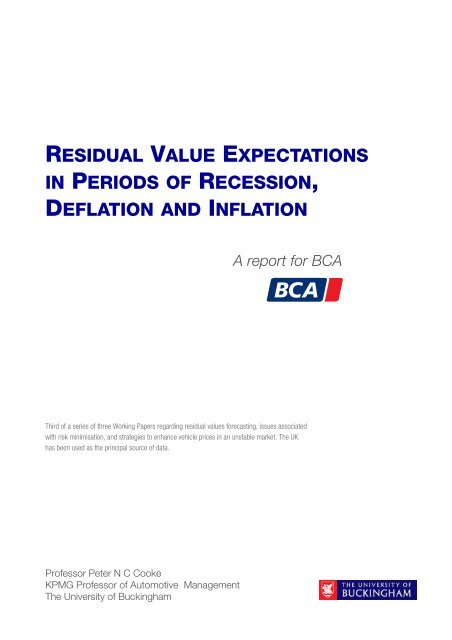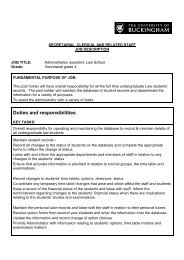residual value expectations in periods of recession, deflation and ...
residual value expectations in periods of recession, deflation and ...
residual value expectations in periods of recession, deflation and ...
You also want an ePaper? Increase the reach of your titles
YUMPU automatically turns print PDFs into web optimized ePapers that Google loves.
RESIDUAL VALUE EXPECTATIONS<br />
IN PERIODS OF RECESSION,<br />
DEFLATION AND INFLATION<br />
A report for BCA<br />
Third <strong>of</strong> a series <strong>of</strong> three Work<strong>in</strong>g Papers regard<strong>in</strong>g <strong>residual</strong> <strong>value</strong>s forecast<strong>in</strong>g, issues associated<br />
with risk m<strong>in</strong>imisation, <strong>and</strong> strategies to enhance vehicle prices <strong>in</strong> an unstable market. The UK<br />
has been used as the pr<strong>in</strong>cipal source <strong>of</strong> data.<br />
Pr<strong>of</strong>essor Peter N C Cooke<br />
KPMG Pr<strong>of</strong>essor <strong>of</strong> Automotive Management<br />
The University <strong>of</strong> Buck<strong>in</strong>gham
Residual Value Expectations<br />
Through Periods <strong>of</strong> Recession<br />
Deflation <strong>and</strong> Inflation<br />
‘Rational’ <strong>in</strong>stead <strong>of</strong> ‘accurate’ is too specific a term; car <strong>residual</strong> <strong>value</strong><br />
forecast<strong>in</strong>g is <strong>of</strong> critical importance to the leas<strong>in</strong>g <strong>in</strong>dustry <strong>in</strong> terms <strong>of</strong> sett<strong>in</strong>g<br />
rental terms <strong>and</strong> be<strong>in</strong>g able to make a satisfactory pr<strong>of</strong>it.<br />
Forecast<strong>in</strong>g becomes<br />
as much a black art as<br />
a discipl<strong>in</strong>ed exercise<br />
Good <strong>residual</strong> forecasts <strong>in</strong> a period <strong>of</strong> economic stability are difficult enough.<br />
However, <strong>in</strong>troduce the extraneous macroeconomic factors <strong>of</strong> <strong>recession</strong>,<br />
<strong>deflation</strong> or <strong>in</strong>flation <strong>in</strong>to the equation, <strong>and</strong> many commentators would argue that<br />
forecast<strong>in</strong>g becomes as much a black art as a discipl<strong>in</strong>ed exercise.<br />
The global economic <strong>recession</strong> knock<strong>in</strong>g at the door dur<strong>in</strong>g the second half <strong>of</strong><br />
2008 <strong>and</strong> manifest<strong>in</strong>g itself <strong>in</strong> early 2009 is no exception.<br />
Objectives<br />
The objectives <strong>of</strong> this brief<strong>in</strong>g note might be summarised as follows;<br />
• To provide automotive user <strong>in</strong>dustry-based work<strong>in</strong>g def<strong>in</strong>itions for the<br />
macroeconomic conditions <strong>of</strong> ‘<strong>recession</strong>’, ‘<strong>deflation</strong>’ <strong>and</strong> ‘<strong>in</strong>flation’, as they<br />
would typically apply to the fleet, leas<strong>in</strong>g <strong>and</strong> daily rental <strong>in</strong>dustries – <strong>and</strong><br />
their associated supply cha<strong>in</strong>s.<br />
• To highlight the pr<strong>in</strong>cipal issues <strong>in</strong>fluenc<strong>in</strong>g <strong>residual</strong> <strong>value</strong>s <strong>and</strong> <strong>residual</strong><br />
<strong>value</strong> <strong>expectations</strong>.<br />
• To exam<strong>in</strong>e pr<strong>in</strong>ciples <strong>and</strong> possible implications for used vehicle operations<br />
<strong>of</strong> the different status <strong>of</strong> the economy, <strong>in</strong> cases <strong>of</strong> normal economic activity,<br />
the economy <strong>in</strong> <strong>recession</strong>, <strong>in</strong> <strong>deflation</strong> <strong>and</strong> dur<strong>in</strong>g <strong>in</strong>flation – without<br />
resort<strong>in</strong>g to a complex computer or mass data analysis.<br />
Despite expensive bespoke <strong>and</strong> generic computer programmes, whole books<br />
<strong>and</strong> bus<strong>in</strong>ess school courses devoted to both forecast<strong>in</strong>g <strong>and</strong> <strong>residual</strong> <strong>value</strong>s,<br />
the current writer has taken the liberty <strong>of</strong> seek<strong>in</strong>g to review the topic <strong>in</strong> a few<br />
pages.<br />
This paper seeks to expla<strong>in</strong> the pr<strong>in</strong>ciples <strong>of</strong> the issues rather than provide a<br />
‘silver bullet’ as a solution. The longer one spends <strong>in</strong> the <strong>in</strong>dustry the more one<br />
becomes conv<strong>in</strong>ced as to just how complicated <strong>and</strong> <strong>in</strong>ter related with other<br />
activities it is.<br />
Residual Value Expectations Through Periods <strong>of</strong> Recession, Deflation <strong>and</strong> Inflation<br />
1
Some work<strong>in</strong>g economic def<strong>in</strong>itions<br />
While it would be possible to use a formal economic def<strong>in</strong>ition for each <strong>of</strong> the<br />
bus<strong>in</strong>ess conditions that might impact on <strong>residual</strong> <strong>value</strong>s, it is perhaps more<br />
useful to develop work<strong>in</strong>g def<strong>in</strong>itions. The follow<strong>in</strong>g are suggested;<br />
• Normal or steady state economy; a period with a steady rate <strong>of</strong> economic<br />
development with <strong>in</strong>flation runn<strong>in</strong>g with<strong>in</strong> the government, EU, ECB or Bank<br />
<strong>of</strong> Engl<strong>and</strong>’s objective growth rates; effectively a ‘steady state economy.<br />
An economy <strong>in</strong> which<br />
output is fall<strong>in</strong>g <strong>and</strong><br />
expected to cont<strong>in</strong>ue<br />
to fall<br />
• Recessionary economy; an economy <strong>in</strong> which output is fall<strong>in</strong>g <strong>and</strong> is<br />
expected to cont<strong>in</strong>ue to fall. Sellers are will<strong>in</strong>g to take a lower than normal<br />
price <strong>and</strong> marg<strong>in</strong> <strong>in</strong> an attempt to keep cash flows positive with the<br />
expectation <strong>of</strong> a foreseeable recovery.<br />
• Economic depression; a prolonged period when an economy cont<strong>in</strong>ues to<br />
decl<strong>in</strong>e albeit at a slow rate, without mov<strong>in</strong>g to a period <strong>of</strong> recovery <strong>and</strong><br />
economic growth – cont<strong>in</strong>u<strong>in</strong>g to run at a level lower than it achieved <strong>in</strong> the<br />
past.<br />
• Deflationary economy; an economy <strong>in</strong> which prices cont<strong>in</strong>ue to fall <strong>and</strong> may<br />
even drop to levels at or below cost <strong>of</strong> production or provision while dem<strong>and</strong><br />
cont<strong>in</strong>ues to decl<strong>in</strong>e.<br />
• Inflationary economy; a bus<strong>in</strong>ess situation where too much money may be<br />
chas<strong>in</strong>g too few goods or services due to lack <strong>of</strong> supply – ‘dem<strong>and</strong> <strong>in</strong>flation’.<br />
The alternative ‘exchange <strong>in</strong>flation’ – an economy show<strong>in</strong>g ‘a rise <strong>in</strong> price<br />
levels due to a weaken<strong>in</strong>g <strong>of</strong> the currency <strong>in</strong> a market that relies on imports<br />
for its goods or services’.<br />
While these five work<strong>in</strong>g def<strong>in</strong>itions provide the basic parameters for chang<strong>in</strong>g<br />
price levels it is still important to <strong>of</strong>fer a further def<strong>in</strong>ition – <strong>in</strong> this case, one that<br />
l<strong>in</strong>ks <strong>residual</strong> <strong>value</strong>s to the alternative states <strong>of</strong> the economy. Consider the<br />
follow<strong>in</strong>g;<br />
The <strong>residual</strong> <strong>value</strong> <strong>of</strong> a motor vehicle is the average price it is<br />
anticipated to achieve if <strong>of</strong>fered for sale today sold through the same<br />
disposal channel.<br />
While the forego<strong>in</strong>g def<strong>in</strong>itions are perhaps a little academic, they give an<br />
<strong>in</strong>dication as to what one is look<strong>in</strong>g at – the expected average <strong>value</strong> a group <strong>of</strong><br />
similar vehicles might achieve at a predeterm<strong>in</strong>ed po<strong>in</strong>t <strong>in</strong> time.<br />
Issues <strong>in</strong>fluenc<strong>in</strong>g future <strong>residual</strong> <strong>value</strong><br />
Residual <strong>value</strong>s can<br />
be <strong>in</strong>fluenced by a<br />
plethora <strong>of</strong> factors<br />
Beyond the four economic states mentioned <strong>in</strong> the previous paragraphs, <strong>residual</strong><br />
<strong>value</strong>s <strong>of</strong> vehicles can be <strong>in</strong>fluenced by a plethora <strong>of</strong> different factors. The<br />
checklist <strong>in</strong> Figure 1 overleaf highlights some which are more widely recognised;<br />
Residual Value Expectations Through Periods <strong>of</strong> Recession, Deflation <strong>and</strong> Inflation<br />
2
To add to the complex group <strong>of</strong> issues to be analysed <strong>and</strong> weighted, leas<strong>in</strong>g<br />
companies need to be able to predict how conditions will have changed by the<br />
time the unit is actually returned for disposal <strong>in</strong> three or four years time.<br />
Figure 1; Issues <strong>in</strong>fluenc<strong>in</strong>g vehicle <strong>residual</strong> <strong>value</strong>s<br />
• State <strong>of</strong> the economy <strong>and</strong> economic sentiment<br />
• Predicted/prejudiced growth/collapse <strong>of</strong> economic <strong>expectations</strong><br />
• Type <strong>of</strong> used vehicle to be <strong>of</strong>fered; age/mileage/condition<br />
• Relative volume <strong>of</strong> similar units on <strong>of</strong>fer<br />
• Availability/price/access <strong>of</strong> f<strong>in</strong>ance <strong>in</strong> used car market<br />
• Vehicle popularity as new unit<br />
• Model replacement plans/<strong>expectations</strong><br />
• Predicted fuel prices/availability<br />
• Credibility <strong>of</strong> model as new/used car<br />
• Rate <strong>of</strong> change <strong>in</strong> technology<br />
• Colour <strong>and</strong> specification <strong>of</strong> used vehicle.<br />
For Illustrative purposes only<br />
Thus, as happened <strong>in</strong> 2008, the economy, far from mov<strong>in</strong>g ahead under firm<br />
prudent <strong>and</strong> economic government as was claimed at the beg<strong>in</strong>n<strong>in</strong>g <strong>of</strong> the year,<br />
moved <strong>in</strong>to a state <strong>of</strong> economic downturn, then to a state <strong>of</strong> predicted <strong>recession</strong><br />
– with all <strong>of</strong> the uncerta<strong>in</strong>ties that status br<strong>in</strong>gs with it.<br />
Residual <strong>value</strong> forecast<strong>in</strong>g <strong>in</strong> economic disequilibrium<br />
The next stage <strong>of</strong> the exercise <strong>in</strong> <strong>residual</strong> <strong>value</strong> forecast<strong>in</strong>g is to establish<br />
benchmark figures from which <strong>residual</strong> <strong>value</strong>s may be predicted.<br />
The <strong>in</strong>dex <strong>in</strong> Figure 2 shows average used car prices achieved at auction <strong>in</strong> the<br />
UK <strong>in</strong> 2007 – although the ‘ongo<strong>in</strong>g average’ over the period showed little<br />
serious fluctuation, there is a slight sign <strong>of</strong> downturn towards the end <strong>of</strong> the<br />
year. This is pretty close to a steady state economy.<br />
Figure 2; Strong <strong>residual</strong> <strong>value</strong> averages at auction; 2007<br />
£7,000<br />
Average Sale Price<br />
2007<br />
£6,500<br />
£6,000<br />
£5,500<br />
£5,000<br />
£4,500<br />
£4,000<br />
1 2 3 4 5 6 7 8 9 10 11 12 13 14 15 16 17 18 19 20 21 22 23 24 25 26 27 28 29 30 31 32 33 34 35 36 37 38 39 40 41 42 43 44 45 46 47 48 49 50 51<br />
Weeks<br />
Source; BCA<br />
Residual Value Expectations Through Periods <strong>of</strong> Recession, Deflation <strong>and</strong> Inflation<br />
3
The trend l<strong>in</strong>e shown <strong>in</strong> Figure 3 shows the fall<strong>in</strong>g average <strong>residual</strong> <strong>value</strong>s for<br />
prices achieved at auction <strong>in</strong> 2008 – demonstrat<strong>in</strong>g a clear downward trend<br />
mov<strong>in</strong>g <strong>in</strong>to a <strong>recession</strong>al situation as happened <strong>in</strong> late <strong>in</strong> the year.<br />
Figure 3; Decl<strong>in</strong><strong>in</strong>g <strong>residual</strong> <strong>value</strong> averages at auction; 2008<br />
£7,000<br />
Average Sale Price - 2008<br />
£6,500<br />
£6,000<br />
£5,500<br />
£5,000<br />
£4,500<br />
£4,000<br />
1 2 3 4 5 6 7 8 9 10 11 12 13 14 15 16 17 18 19 20 21 22 23 24 25 26 27 28 29 30 31 32 33 34 35 36 37 38 39 40 41 42 43 44 45 46 47 48 49 50 51 52<br />
Weeks<br />
Source; BCA<br />
A third trend shown, not illustrated, but similar to that shown <strong>in</strong> Figure 2, could<br />
be seen as <strong>in</strong>flationary <strong>and</strong> would represent a steep rise <strong>in</strong> <strong>residual</strong> <strong>value</strong>s<br />
because new car prices were ris<strong>in</strong>g too. This is a serious trend l<strong>in</strong>e <strong>and</strong><br />
represents monetary price escalation. From fleet operators’ viewpo<strong>in</strong>t, new car<br />
prices would also be escalat<strong>in</strong>g <strong>in</strong> monetary terms.<br />
There is some concern, as yet fairly quiet, that if the economy slips <strong>in</strong>to a period<br />
<strong>of</strong> prolonged <strong>recession</strong> or even <strong>deflation</strong>, when it recovers it may move <strong>in</strong>to a<br />
period <strong>of</strong> <strong>in</strong>flation, driven by the funds that have been pumped <strong>in</strong>to the economy<br />
– that is an issue for a later work<strong>in</strong>g paper should it happen.<br />
A well nigh impossible forecast is to be able to spot the po<strong>in</strong>t when <strong>residual</strong><br />
<strong>value</strong>s stop fall<strong>in</strong>g <strong>and</strong> beg<strong>in</strong> to recover; the most useful management tool for<br />
that would be ‘luck’.<br />
The challenge for<br />
Used Car Sales<br />
Managers is to predict<br />
figures 2-3-4 ahead<br />
The challenge for Used Car Sales Managers is to be able to predict these figures<br />
2-3-4 years ahead, <strong>and</strong> forecast with great confidence what average <strong>residual</strong><br />
<strong>value</strong>s <strong>of</strong> clutches <strong>of</strong> essentially similar vehicles will be. That could perhaps<br />
expla<strong>in</strong> why the average period <strong>of</strong> employment <strong>of</strong> a remarket<strong>in</strong>g manager is<br />
around three years.<br />
The follow<strong>in</strong>g paragraphs seek to present the issues associated with predict<strong>in</strong>g<br />
<strong>residual</strong> <strong>value</strong>s <strong>in</strong> each <strong>of</strong> the economic scenarios noted previously.<br />
Residual Value Expectations Through Periods <strong>of</strong> Recession, Deflation <strong>and</strong> Inflation<br />
4
Steady state <strong>residual</strong> <strong>value</strong> characteristics<br />
In a steady state economy, given a free supply <strong>and</strong> dem<strong>and</strong> for used vehicles,<br />
average <strong>residual</strong> <strong>value</strong> forecasts can be relatively predictable <strong>and</strong> to all <strong>in</strong>tents<br />
should rema<strong>in</strong> steady. There could be some fluctuation driven by temporary<br />
excess <strong>in</strong> supply or dem<strong>and</strong>. For example, a major defleet<strong>in</strong>g to a local used<br />
vehicle market could depress <strong>residual</strong>s until those units have been flushed<br />
through the system. Similarly, there could be a fall-<strong>of</strong>f for specific models if they<br />
prove unpopular either as new or used cars, or if a model change is imm<strong>in</strong>ent.<br />
The simple rule <strong>of</strong> thumb for used vehicle <strong>residual</strong> <strong>value</strong> forecast<strong>in</strong>g would be an<br />
equation similar to that shown below;<br />
Current new car price<br />
Orig<strong>in</strong>al new car price x Current average <strong>residual</strong> % =<br />
Forecast RV for<br />
current car at<br />
same age <strong>and</strong><br />
condition<br />
Such an equation <strong>in</strong>corporates a small degree <strong>of</strong> proportionality <strong>in</strong>to the<br />
equation which some might call unnecessary, but the implication is that figures<br />
could move up or down.<br />
The route to disposal with this state <strong>of</strong> the economy might be summarised as<br />
‘most cost-effective m<strong>in</strong>imis<strong>in</strong>g transaction costs’.<br />
Inflationary pressures on <strong>residual</strong> <strong>value</strong>s<br />
The pressures here would <strong>in</strong>dicate a steady rise <strong>in</strong> the monetary <strong>residual</strong> <strong>value</strong>s<br />
<strong>of</strong> units. The implication for fleet operators, leas<strong>in</strong>g companies or dealers is that<br />
the monetary <strong>residual</strong> <strong>value</strong> achieved may be ‘pleasantly high’ compared with<br />
the steady state situation.<br />
The st<strong>in</strong>g <strong>in</strong> the tail is<br />
that prices will have<br />
escalated<br />
The st<strong>in</strong>g <strong>in</strong> the tail is that, <strong>in</strong> monetary terms, the price will have escalated<br />
significantly from the time the unit now be<strong>in</strong>g replaced was acquired. That<br />
difference <strong>in</strong> new unit prices will dem<strong>and</strong> a significantly higher monetary<br />
acquisition price.<br />
A simple rule <strong>of</strong> thumb equation to provide a start<strong>in</strong>g po<strong>in</strong>t for such forecasts<br />
<strong>and</strong> work<strong>in</strong>g on a sample <strong>of</strong> used vehicles <strong>of</strong> a specific type might be as shown<br />
<strong>in</strong> the equation below. Such an equation can easily be used with a laptop to<br />
sample a group <strong>of</strong> vehicles – but it illustrates the po<strong>in</strong>t.<br />
Used vehicle price at given<br />
mileage <strong>and</strong> time [1]<br />
Current new car price [2]<br />
x =<br />
New car price [3]<br />
Projected used<br />
car price [4]<br />
Residual Value Expectations Through Periods <strong>of</strong> Recession, Deflation <strong>and</strong> Inflation<br />
5
[1] Average mileage, time <strong>and</strong> condition for current vehicles taken over a<br />
common period <strong>and</strong> <strong>of</strong> the same age.<br />
[2] Current new vehicle price for units whose projected used vehicle price is<br />
sought.<br />
[3] New vehicle price <strong>of</strong> the sample <strong>of</strong> vehicles used <strong>in</strong> [1].<br />
[4] Projected used vehicle price <strong>of</strong> the sample under evaluation, at the same<br />
mileage <strong>and</strong> condition.<br />
From a negotiators’ viewpo<strong>in</strong>t there is a dist<strong>in</strong>ct benefit <strong>in</strong> be<strong>in</strong>g <strong>in</strong> goods rather<br />
than <strong>in</strong> cash, as money is slipp<strong>in</strong>g <strong>in</strong> <strong>value</strong> – if <strong>in</strong>flation is serious, there could be<br />
a serious loss <strong>in</strong> monetary <strong>value</strong>. Goods – i.e. vehicles can appreciate <strong>in</strong><br />
monetary terms, while money does not <strong>and</strong> decl<strong>in</strong>es <strong>in</strong> purchas<strong>in</strong>g power.<br />
Options that might be considered to maximise <strong>residual</strong> <strong>value</strong>s, <strong>and</strong> m<strong>in</strong>imise the<br />
difference with the replacement car price, would be to seek a part-exchange<br />
deal or to put the vehicle through auction as close to the po<strong>in</strong>t the replacement<br />
new unit has to be f<strong>in</strong>anced as possible.<br />
The critical issue is the new vehicle price.<br />
Recessional or <strong>deflation</strong>ary pressures on <strong>residual</strong> <strong>value</strong>s<br />
Get the unit to market<br />
as quickly as possible<br />
In this case, f<strong>in</strong>ancial pressures would normally encourage sellers to move <strong>in</strong>to<br />
cash as quickly as possible – <strong>in</strong> that the predicted average monetary <strong>residual</strong><br />
<strong>value</strong> might be expected to fall <strong>in</strong> the future. Hence, get the unit to market as<br />
fast as possible.<br />
However, for buyers <strong>of</strong> used vehicles the opposite is true – buy<strong>in</strong>g those units as<br />
late as possible, <strong>in</strong> the expectation that <strong>residual</strong> <strong>value</strong>s will cont<strong>in</strong>ue to decl<strong>in</strong>e.<br />
From a dealership viewpo<strong>in</strong>t, the message is simple ‘keep used car stock to a<br />
m<strong>in</strong>imum <strong>and</strong> turn it over as fast as possible.’ Equally important, is the dealer<br />
trad<strong>in</strong>g message – ‘target your market <strong>and</strong> seek fast turnover, reduc<strong>in</strong>g prices if<br />
units do not sell quickly enough – <strong>and</strong> have a base price at which the unit will be<br />
sent to auction <strong>and</strong> replaced.’<br />
The key to m<strong>in</strong>imis<strong>in</strong>g<br />
losses is to ‘shift the<br />
metal as fast as<br />
possible’<br />
From leas<strong>in</strong>g companies’ viewpo<strong>in</strong>t, the key to m<strong>in</strong>imis<strong>in</strong>g losses, <strong>in</strong> a period <strong>of</strong><br />
collaps<strong>in</strong>g used vehicle prices, is to ‘shift the metal as fast as possible <strong>and</strong><br />
convert to cash or k<strong>in</strong>d quickly’. That might be h<strong>and</strong>led either by part-exchange<br />
aga<strong>in</strong>st a replacement unit, or sell<strong>in</strong>g quickly through auction.<br />
‘Fleet hygiene’ is a phrase that spr<strong>in</strong>gs to m<strong>in</strong>d – ‘no spare units or units subject<br />
to delay on the way to disposal’ – assume their <strong>residual</strong> <strong>value</strong>s drop every day<br />
the unit is reta<strong>in</strong>ed.<br />
Residual Value Expectations Through Periods <strong>of</strong> Recession, Deflation <strong>and</strong> Inflation<br />
6
Some conclusions<br />
One <strong>of</strong> the keys to pr<strong>of</strong>itable leas<strong>in</strong>g programmes that has come to the fore <strong>in</strong><br />
the past year or so, is the ability to predict realistic <strong>residual</strong> <strong>value</strong>s for vehicles 2-<br />
3-4 years ahead – <strong>and</strong> then to dispose <strong>of</strong> those units as pr<strong>of</strong>itably as possible.<br />
This short brief<strong>in</strong>g paper has exam<strong>in</strong>ed some <strong>of</strong> the critical issues associated<br />
with disposal <strong>and</strong> predictions.<br />
The key to m<strong>in</strong>imis<strong>in</strong>g<br />
losses is to ‘shift the<br />
metal as fast as<br />
possible’<br />
Best-practice is much the same <strong>in</strong> all three cases – steady state economy,<br />
<strong>in</strong>flation <strong>and</strong> <strong>recession</strong> or decl<strong>in</strong><strong>in</strong>g <strong>residual</strong>s. Perhaps the key consideration is<br />
as much the cost <strong>of</strong> the replacement vehicle <strong>and</strong> the relationship between the<br />
<strong>residual</strong> anticipated on the current unit <strong>and</strong> the differential to the price <strong>of</strong> the<br />
replacement.<br />
In the period <strong>of</strong> double digit <strong>in</strong>flation <strong>in</strong> the late 1970s, otherwise thriv<strong>in</strong>g leas<strong>in</strong>g<br />
companies went out <strong>of</strong> bus<strong>in</strong>ess because they were unable to manage the<br />
crucial relationship between <strong>residual</strong> <strong>value</strong> <strong>of</strong> the current unit <strong>and</strong> the monetary<br />
price <strong>of</strong> the replacement vehicle effectively enough.<br />
One hope is that the economy does not move through a period <strong>of</strong> <strong>recession</strong><strong>deflation</strong><br />
then sudden <strong>in</strong>flation, as the massive quantities <strong>of</strong> liquidity that have<br />
been <strong>and</strong> are be<strong>in</strong>g pushed <strong>in</strong>to the economy suddenly come home to roost.<br />
The real concern is that, at the time <strong>of</strong> writ<strong>in</strong>g, the word ‘<strong>deflation</strong>’ is be<strong>in</strong>g used<br />
far more by responsible analysts than it was dur<strong>in</strong>g late 2008.<br />
Pr<strong>of</strong>essor Peter N C Cooke<br />
KPMG Pr<strong>of</strong>essor <strong>of</strong> Automotive Management<br />
The University <strong>of</strong> Buck<strong>in</strong>gham January 2009<br />
Residual Value Expectations Through Periods <strong>of</strong> Recession, Deflation <strong>and</strong> Inflation<br />
7

















